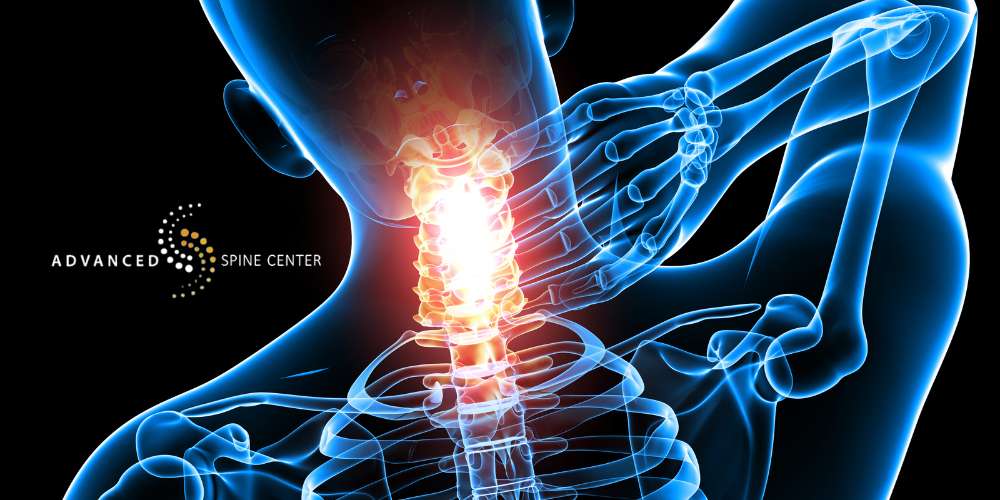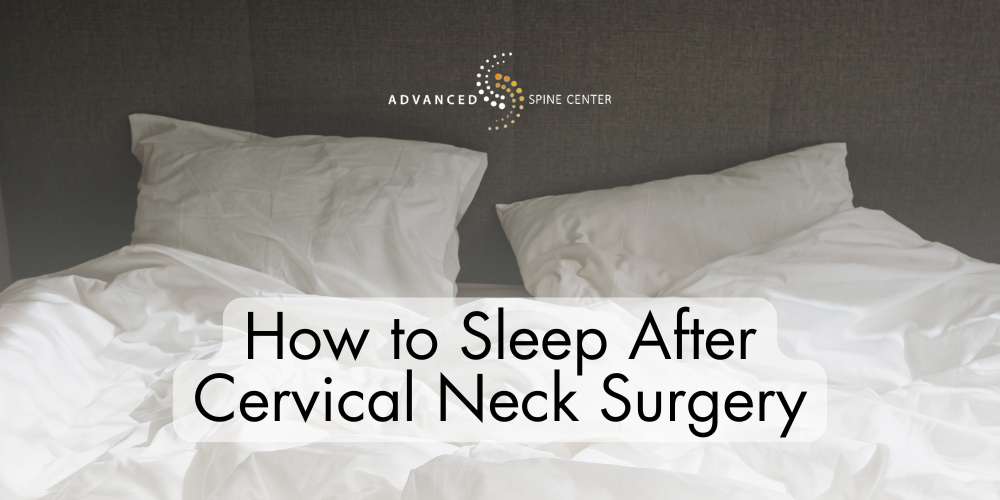Undergoing cervical neck surgery can be a major step toward pain relief, but the recovery process often raises many questions, including how to get a good night’s sleep.
Finding the right way to sleep after surgery is crucial for reducing discomfort, supporting healing, and avoiding unnecessary strain on your neck and spine. In this blog, we’ll explore how to sleep after cervical neck surgery, from the best sleeping positions to essential tips for minimizing pain.
If you have questions about recovery after neck and spinal surgery, contact Advanced Spine Center at (972) 499-5457 to speak with a Plano cervical spine specialist.
Why Is Cervical Neck Surgery Performed?
Cervical neck surgery is performed to relieve persistent pain, numbness, or weakness caused by compression of the spinal cord or nerves in the cervical spine. This compression is often caused by herniated discs, spinal stenosis, or degenerative disc disease, which can lead to significant discomfort, limited mobility, and even nerve damage. These medical conditions place pressure on the nerves that travel through the cervical spine, resulting in symptoms that may extend from the neck to the shoulders, arms, and hands.
The primary goal of cervical neck surgery is to remove or modify the structures causing nerve compression. This may involve removing part of a herniated disc, widening the spinal canal, or fusing certain vertebrae to stabilize the spine.
How Long Do You Wear a Cervical Collar After ACDF Surgery?
After an anterior cervical discectomy and fusion (ACDF) surgery, a cervical collar is often recommended to support the neck and promote healing. Generally, patients are advised to wear the neck collar for two to six weeks post-surgery to keep the neck stable and reduce excessive movement that could strain the healing area.
Many patients use a hard collar initially to provide firm support and reduce excessive movement during the early stages of recovery. As healing continues, some may transition to a soft collar, which still offers stability but allows for a bit more comfort and mobility. After surgery, neck collars provide much-needed support to the cervical spine as it fuses and strengthens.
How Long Does It Take for Nerves to Heal After Neck Surgery?
Nerve healing after neck surgery can be gradual, often taking several months to over a year, depending on the extent of nerve damage. Once pressure on the nerves is relieved, they begin to regenerate, but full recovery is typically slow.
Patients may experience small improvements in symptoms, such as reduced pain or numbness, within the first few weeks, though complete nerve healing can take longer. Each individual’s recovery is unique, and factors like overall health and adherence to post-surgical care can influence the healing rate.
How Long Does It Take to Recover from Neck Surgery C2-C3-C4-C5-C6-C7?

Recovery time from neck and spinal surgery can vary depending on the specific vertebrae involved, the extent of the procedure, and individual healing rates. Generally, initial recovery after spine surgery takes a few weeks, but full recovery can take several months.
During this time, the body works to heal the bones and tissues around the cervical spine while adapting to any structural changes. Patients may notice gradual improvements in pain and mobility as healing progresses, though post-operative care and physical therapy are often essential to support recovery and regain full function.
Neck Surgery C5-C6-C7 Recovery Time
Neck and spine surgery involving the C5-C6-C7 vertebrae, located at the lower end of the cervical spine, often requires a few months for full recovery, with noticeable improvements usually starting within the first six weeks. These vertebrae are usually operated on to relieve nerve compression or stabilize the spine.
During the initial healing phase, patients may be advised to limit certain activities and wear a neck collar to prevent excessive movement and protect the surgical area. Full recovery can take several months, depending on the extent of the surgery and adherence to post-operative care.
Neck Surgery C3-C4-C5-C6-C7 Recovery Time
When neck and spine surgery involves a broader section of vertebrae, recovery may be slightly longer due to the larger area of the spine impacted. For many patients, the initial healing period may take several weeks.
As healing progresses, physical therapy often becomes a top priority post-surgery, helping patients regain strength and flexibility across the affected vertebrae. Recovery from surgery at multiple levels may extend to several months, with patients gradually resuming normal activities under the guidance of their spinal surgeon.
Tips for How to Sleep After Cervical Neck Surgery

Getting quality sleep after spinal surgery is essential for recovery, but it can be challenging due to post-operative discomfort and movement restrictions. Adopting the right sleeping habits can ease the strain on the neck and promote healing, helping you feel more rested each day.
One of the most important tips is to change positions slowly and carefully to avoid putting stress on the neck. The log roll technique is often recommended and involves moving the whole body as one unit to minimize twisting, which can help keep the spine aligned and reduce pain.
Small adjustments to your sleeping positions and supportive pillows can significantly improve your comfort during recovery. In the following sections, we’ll explore specific sleeping positions and practical tips on how to sleep after cervical neck surgery.
Best Sleeping Position After Cervical Neck Surgery
The best sleeping positions after cervical neck surgery keep your spine aligned and minimize pressure on the neck. For many patients, sleeping on their back with a slight incline or on their side with proper neck support can offer comfort while maintaining spinal alignment.
These sleeping positions can help reduce strain on the neck, allowing the surgical area to heal more comfortably. Choosing a sleeping position that supports the neck and spine can also alleviate post-operative discomfort, making it easier to get a good night’s sleep.
Sleeping on Your Side
Sleeping on your side can be a comfortable option after neck surgery. To avoid twisting or straining the neck, it’s important to keep the spine straight, using an orthopedic pillow that cradles the head and neck in alignment with the body. Placing a pillow between your knees can help maintain spinal alignment and provide additional support for the cervical spine.
Sleeping Upright
For some patients, sleeping upright can be a practical way to support healing and reduce neck strain after surgery. Sleeping in a recliner or propping up with multiple pillows to create a slightly upright position can help prevent unnecessary pressure on the neck. This position may also help manage swelling or discomfort during early recovery.
Sleeping on Your Stomach
Sleeping on your stomach is generally not recommended after spine surgery. This sleeping position can strain the cervical spine and cause unnecessary twisting, which may lead to discomfort and interfere with healing. For optimal recovery, patients are usually encouraged to avoid stomach sleeping and focus on positions that support the spine’s natural alignment.
Sleeping on Your Back
Sleeping on your back is often considered one of the best positions after neck surgery, as it helps maintain proper spinal alignment. Elevating the head slightly with a supportive pillow can ease neck strain, and placing a pillow under the knees can help relieve pressure on the lower back.
This sleeping position allows the cervical spine to rest comfortably, reducing the risk of excessive movement and providing much-needed support for the surgical area.
Must-Haves After Neck Surgery for Sleeping
Certain items are essential for sleeping more comfortably after neck and spine surgery. A supportive mattress and pillows designed for spinal alignment can significantly reduce neck strain and promote restful sleep. Your spinal surgeon may also recommend neck braces or soft collars to stabilize the neck and reduce movement while sleeping.
A Supportive Mattress and Pillows
A supportive mattress and the right pillows are important for a comfortable recovery. An orthopedic or contoured pillow designed to cradle the neck can help keep the spine aligned and reduce pressure on the surgical site. A mattress that offers firm, even support can help prevent sinking or twisting during sleep, which is important for keeping the neck stable.
Neck Brace
Wearing a neck brace or cervical collar while sleeping can help stabilize the neck and prevent excessive movement during the early stages of recovery. A neck brace provides added support, particularly in the first few weeks after surgery, helping to protect the surgical area as the body begins to heal. Soft collars may be worn at night to reduce discomfort while still providing stability.
How to Sit After Cervical Neck Surgery

After cervical neck surgery, sitting in a way that supports your spine and minimizes strain on the neck is crucial for a comfortable and safe recovery. Begin by choosing a chair that provides firm back support and encourages an upright posture.
When sitting, keep your back straight, shoulders relaxed, and feet flat on the floor to promote proper spinal alignment. Avoid slouching or leaning forward, as these positions can add unnecessary pressure to the cervical spine. Additionally, using a small pillow or rolled towel behind the lower back can help maintain the spine’s natural curve, reducing tension on the neck.
If prescribed, wearing a neck collar while seated can add stability and remind you to limit excessive movement. Taking breaks to stand and walk every 30 to 45 minutes also helps to avoid stiffness and keeps circulation flowing.
What to Avoid After Cervical Fusion and Other Cervical Spine Surgeries
After cervical fusion and other cervical spine surgeries, it’s important to avoid movements and activities that could place strain on the neck and disrupt the healing process. Patients should avoid heavy lifting, bending, twisting, or any rapid or jerking neck movements. High-impact activities, such as running, jumping, or contact sports, are also discouraged until the spine has sufficiently healed, as these can lead to complications or re-injury.
Avoid prolonged periods of sitting or standing in the same position, as this can cause stiffness and discomfort in the cervical spine. Also, avoid sleeping on your stomach and using unsupportive pillows, as they can move the neck in unnatural positions.
Contact the Advanced Spine Center for Cervical and Thoracic Spine Surgery in Plano

Recovering from cervical and thoracic spine surgery requires the right guidance and support to ensure a smooth, successful healing process. At the Advanced Spine Center, our nursing staff is dedicated to helping you manage recovery with expert advice tailored to your needs.
Whether you have questions about post-surgery care, the best sleeping positions, or other healing aspects, we’re here to help. Don’t let neck or back pain hold you back—call the Advanced Spine Center at (972) 499-5457 to discuss how we can support you on your journey to recovery.










